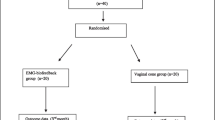Abstract
Introduction and hypothesis
Vaginal weight cone (VWC) versus assisted pelvic floor muscle training (APFMT) in the treatment of urinary incontinence (UI) in women.
Methods
One hundred three incontinent women were randomly distributed into two groups: group G1 (n = 51) treated with VWC and G2 (n = 52), APFMT. The following parameters were performed initially and after treatment: (1) clinical questionnaire, (2) visual analogue scale (VAS), (3) 60-min pad test, and (4) subjective and objective assessment of pelvic floor muscle (PFM).
Results
There was a significant decrease in nocturia and urine loss after treatment in both groups (p < 0.05). In VAS, there was a significant improvement of all parameters in both groups (p < 0.05). The pad test showed significant decrease in both groups (p < 0.05). There was a significant increase of PFM strength in both groups (p < 0.05).
Conclusion
There was no difference between groups treated with VWC and APFMT.

Similar content being viewed by others
Abbreviations
- VWC:
-
Vaginal weight cone
- APFMT:
-
Assisted pelvic floor muscle training
- UI:
-
Urinary incontinence
- G1:
-
Group 1
- G2:
-
Group 2
- VAS:
-
Visual analogue scale
- PFM:
-
Pelvic floor muscles
- PFMT:
-
Pelvic floor muscles training
- SUI:
-
Stress urinary incontinence
- T0:
-
Before the treatment
- T6:
-
Six months after treatment
- T12:
-
Twelve months after treatment
- TDP:
-
Transvaginal digital palpation
- g:
-
Gram
- min:
-
Minutes
References
Holley RL, Varner RE, Kerns DJ, Mestecky PJ (1995) Long-term failure of pelvic floor musculature exercises in treatment of genuine stress incontinence. South Med J 165:322–329
Arvonen T, Fianu-Jonasson A, Tyni-Lenné R (2001) Effectiveness of two conservative modes of physical therapy in women with urinary stress incontinence. Neurourol Urodyn 20:591–599
Hay-Smith EJ, Dumoulin C (2006) Pelvic floor muscle training versus no treatment, or inactive control treatments, for urinary incontinence in women. Cochrane Database Syst Rev 25:CD005654
Peattie AB, Plevnik S, Stanton SL (1988) Vaginal cones: a conservative method of treating genuine stress incontinence. Br J Obstet Gynecol 95:1049–1053
Plevnik S (1994) Vaginal cones. In: Shussler B, Laycock J, Norton P, Stanton SL (eds) Pelvic floor re-education principles and practice. Springer, London, pp 139–142
Herbison GP, Dean N (2002) Weighted vaginal cones for urinary incontinence. Cochrane Database Syst Rev (1):CD002114. doi:10.1002/14651858.CD002114
Jonasson A, Larsson B, Pschera H (1989) Testing and training of the pelvic floor muscles after childbirth. Acta Obstet Gynecol Scand 68:301–304
Bo K, Talseth T, Holme I (1999) Single blind, randomized controlled trial of pelvic floor exercises, electrical stimulation, vaginal cones, and no treatment in management of genuine stress incontinence in women. Br Med J 318:487–493
Halbe HW (1993) Tratado de Ginecologia Roca. São Paulo
Amaro JL, Moreira ECH, Gameiro MO, Padovani CR (2005) Pelvic floor muscle evaluation in incontinent patients. Int Urogynecol J 16:352–354
Laycock J, Green RJ (1988) Interferential therapy in the treatment of incontinence. Phisiotherapy 74:161–168
Goodman LA (1965) On simultaneous confidence intervals for multinomial proportions. Technometrics 7:47–254
Johnson RA, Wichern DW (2002) Applied multivariate statistical analysis, 5th edn. Prentice-Hall, Upper Saddle River, p 767
Cammu H, Van Nylen M (1998) Pelvic floor exercises versus vaginal weight cones in genuine stress incontinence. Eur J Obstet Gynecol Reprod Biol 77:89–93
Amaro JL, Gameiro MO, Padovani CR (2003) Treatment of urinary stress incontinence by intravaginal electrical stimulation and pelvic floor physiotherapy. Int Urogynecol J 14:204–208
Wrigley T (1995) The effect of training with vaginal weighted cones and pelvic floor exercises on the strengh of the pelvic floor muscles: a pilot study. Int Urogynecol J 6:4–9
Deindl FM, Schüssler B, Vodusek DB, Hesse U (1995) Neurophysiologic effect of vaginal cone application in continent and urinary stress incontinent women. Int Urogynecol J 6:204–208
Conflicts of interest
None.
Author information
Authors and Affiliations
Corresponding author
Rights and permissions
About this article
Cite this article
Gameiro, M.O., Moreira, E.H., Gameiro, F.O. et al. Vaginal weight cone versus assisted pelvic floor muscle training in the treatment of female urinary incontinence. A prospective, single-blind, randomized trial. Int Urogynecol J 21, 395–399 (2010). https://doi.org/10.1007/s00192-009-1059-7
Received:
Accepted:
Published:
Issue Date:
DOI: https://doi.org/10.1007/s00192-009-1059-7




